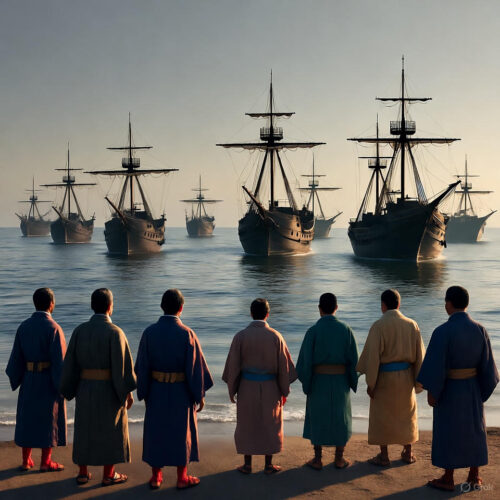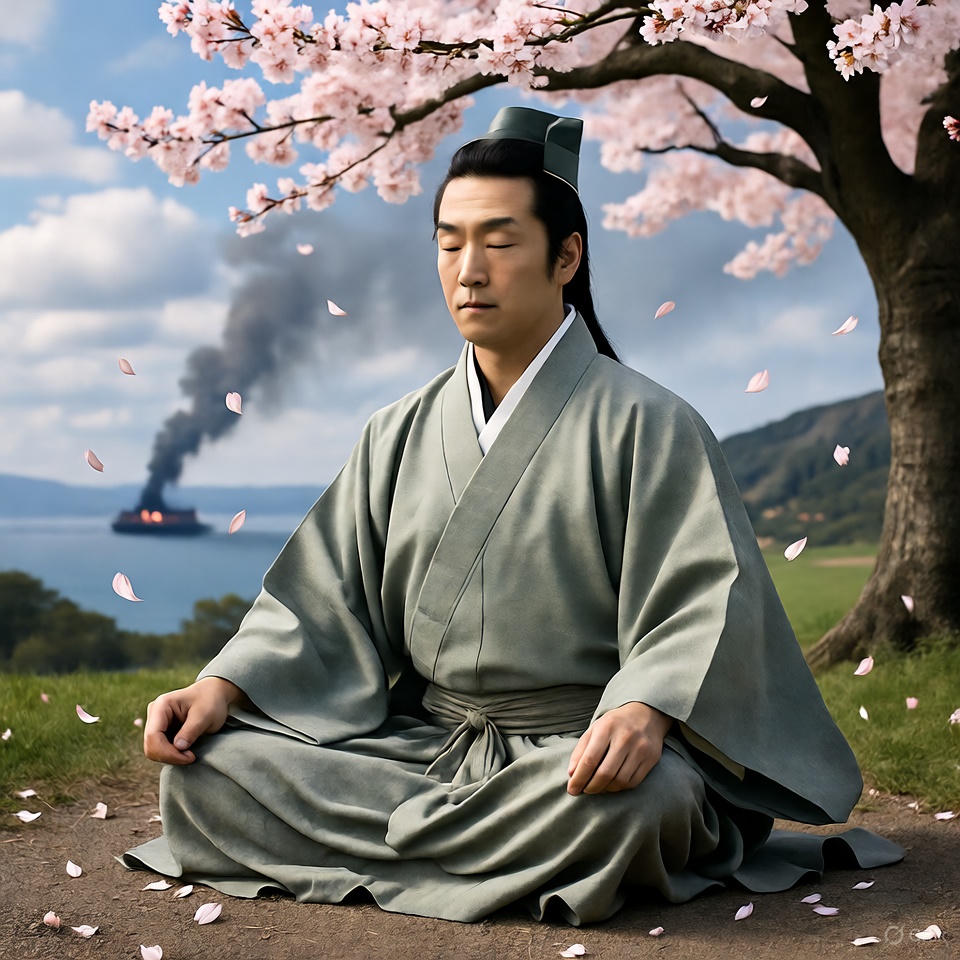In the annals of history, few moments capture the raw clash of empires like the Mongol invasion of Japan that began on October 5, 1274. This wasn’t just a skirmish; it was the opening salvo of Kublai Khan’s audacious bid to extend the vast Mongol Empire across the seas to the archipelago nation of Japan. Picture a horizon darkened by hundreds of warships, carrying tens of thousands of battle-hardened warriors from the steppes of Asia, slicing through the waves toward an island chain defended by a warrior class forged in the fires of feudal loyalty and unyielding honor. The Mongols, fresh from subjugating China and Korea, saw Japan as the next jewel in their crown. But what unfolded on the shores of Tsushima Island was a tale of ferocity, innovation in warfare, and the unpredictable wrath of nature that would echo through centuries.
To understand this pivotal day, we must delve into the backdrop of the 13th century. The Mongol Empire, under Genghis Khan’s successors, had become the largest contiguous land empire in history, stretching from Eastern Europe to the Sea of Japan. Kublai Khan, Genghis’s grandson, ascended as the Great Khan in 1260 and founded the Yuan Dynasty in China by 1271, with his capital at Khanbaliq (modern-day Beijing). His eyes turned to Japan after repeated diplomatic overtures were rebuffed. Between 1266 and 1273, Mongol envoys, often accompanied by Korean subordinates from the vassal state of Goryeo, arrived in Japan demanding submission. These missions, totaling six, were met with disdain by the Kamakura shogunate, Japan’s military government led by the Hōjō clan. Shikken Hōjō Tokimune, the regent wielding real power, viewed the demands as beneath notice. Envoys were turned away without reply, sometimes harassed or attacked, signaling Japan’s isolationist stance and refusal to bow to foreign overlords.
Japan in 1274 was a land of samurai, bound by the bushido code emerging in its nascent form, under the feudal system where local lords (gokenin) owed allegiance to the shogun. The Imperial Court in Kyoto held ceremonial power, but the Hōjō clan’s iron grip on the shogunate meant decisions were made in private councils, bypassing traditional consultations. Preparations for potential invasion had been underway: Shinto shrines and Buddhist temples were enlisted to pray for divine protection, and coastal defenses in Kyushu were bolstered. Yet, the Japanese forces were modest—estimates suggest only 4,000 to 6,000 samurai scattered across key islands, relying on opportunistic guerrilla tactics rather than a unified army.
On the Mongol side, the invasion force was a multinational juggernaut. Kublai ordered the assembly of a fleet in April 1274, drawing from Yuan resources: 15,000 Mongol, Han Chinese, and Jurchen troops, supplemented by 6,000–8,000 Korean soldiers and 7,000 sailors. The Goryeo Koreans, resentful vassals after decades of Mongol conquest, were coerced into building 900 ships—300 large transports, 300 fast attack boats, and 300 tenders—modeled on southern Chinese designs. These vessels were flat-bottomed and sturdy but ill-suited for open-sea voyages, a flaw that would prove fateful. Generals like Holdon, Hong Dagu, and Liu Fuheng led the armada, which departed from Hoppo (near modern Masan, South Korea) in early November (corresponding to late October in some calendar alignments, with the Tsushima landing pegged to October 5 in historical records).
The armada’s approach was ominous. Villagers on Tsushima spotted the sails on the horizon, a sight that must have filled them with dread. Tsushima, a rugged island straddling the Korea Strait, served as Japan’s first line of defense. Its deputy governor, Sō Sukekuni, rallied about 80 mounted samurai and their retainers—a paltry force against the estimated 8,000 Yuan warriors disembarking. As dawn broke on October 5, Mongol negotiators approached under a flag of parley, but Japanese archers repelled them. Combat erupted around 4 a.m., with the samurai charging in traditional style, seeking individual glory through duels. Yet the Mongols employed alien tactics: dense phalanxes shielded by wooden screens, polearms thrust in unison, and volleys of arrows that decimated the lightly armored Japanese cavalry.
Sō Sukekuni fought valiantly, his forces holding initial positions near Komoda Beach and Sasuura Port. Legends recount samurai like Sukesada slaying dozens in single combat, their katanas flashing against Mongol scimitars. But numbers overwhelmed: the island’s defenses crumbled by nightfall. Sukekuni led a desperate cavalry charge, only to fall in the melee. The Mongols, true to their reputation for terror, massacred inhabitants, burned villages, and desecrated shrines—a fire at the Hachiman Shrine was seen by survivors as a divine omen. Over the next days, Tsushima fell completely, its population slaughtered or enslaved, setting a grim tone for the campaign.
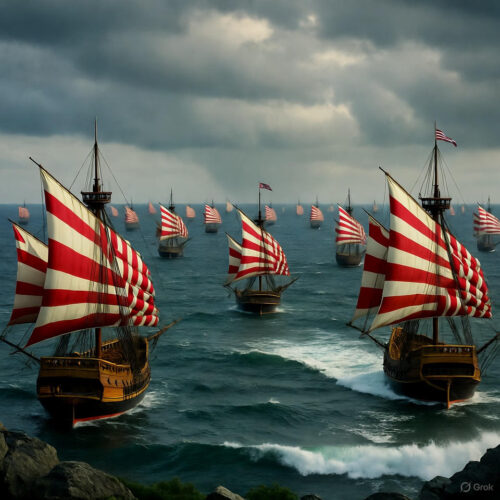
Emboldened, the Yuan fleet pressed on to Iki Island on October 13 (lunar calendar adjustments aligning with the sequence). Governor Taira no Kagetaka mustered 100 samurai and local militias, retreating to his fortress. The battle was brutal: Mongols surrounded the castle, archers picking off defenders. Kagetaka’s daughter was smuggled out via a secret passage but slain by arrows; a loyal samurai, Sōzaburō, escaped to warn Hakata Bay. In a final act of defiance, Kagetaka sortied with 36 men, most perishing before he committed seppuku with his family. Japanese chronicles describe Mongol atrocities—women stabbed through the palms, stripped, and bound to ships as macabre trophies—fueling a narrative of barbarian savagery.
By October 19–20, the invasion reached its climax at Hakata Bay on Kyushu’s mainland, the gateway to Japan proper. Here, the Battle of Bun’ei unfolded. Japanese reinforcements, perhaps 3,000–6,000 strong under lords like Kikuchi Takefusa, faced the weary but numerous Yuan troops. Samurai were stunned by Mongol innovations: explosive “thunder crash bombs” (early gunpowder devices encased in iron or paper), hand-drums signaling coordinated advances, and firearms possibly including proto-cannons. Horses panicked from the blasts, disrupting cavalry charges. Takezaki Suenaga, a rogue samurai defying orders, charged with five comrades, bogging in mud and retreating under arrow fire after slaying several foes. The Mongols pushed inland, burning Hakata and killing up to 2,000 defenders, but exhaustion and wounds— including General Liu Fuxiang shot in the face—halted them.
As night fell, debate raged among Mongol leaders. Holdon pushed for a night assault, but caution prevailed amid fears of ambushes. By dawn on October 23, the fleet had vanished. A fierce storm—later mythologized as the first “kamikaze” or divine wind—struck, dashing hundreds of ships on rocks and drowning thousands. Of the 30,000 invaders, only about 16,500 returned; 200 vessels were lost. Japanese captives from beached wrecks were executed, and the shogunate claimed victory, though at great cost in lives and islands ravaged.
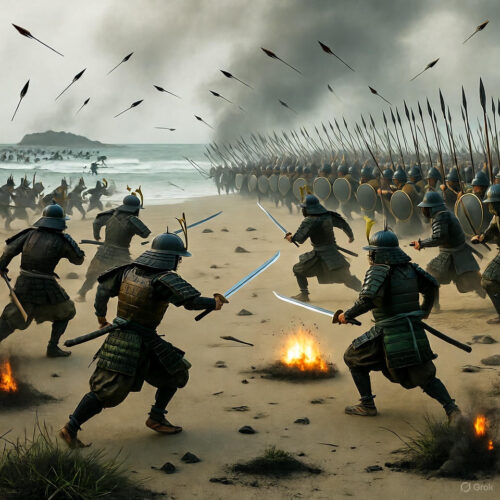
The failure wasn’t mere luck; it exposed Mongol naval weaknesses. Their ships, built hastily by reluctant Koreans, lacked deep keels for stormy seas. Japanese resilience shone through: post-invasion, Hōjō Tokimune consulted Zen master Mugaku Sogen, embracing meditation to steel his will, which bolstered Zen’s influence on samurai culture and bushido’s development. Fortifications rose—stone walls at Hakata Bay, river stakes—preparing for the 1281 rematch, which also failed due to another typhoon. The invasions introduced gunpowder to Japan, spurring sword innovations by masters like Masamune, who crafted lighter tachi blades to counter Mongol armor.
Broader consequences rippled outward. For the Yuan, resources drained: Korea’s forests denuded for ships, naval power crippled. Kublai’s prestige waned, deterring further overseas ambitions; even the Ming Dynasty later cited these failures in abandoning invasion plans. In Japan, the shogunate’s inability to reward vassals with spoils sowed seeds of discontent, weakening Hōjō authority and fueling later civil strife. Yet, the narrative of divine intervention fostered national identity, with “kamikaze” becoming a symbol of protection—repurposed tragically in World War II.
Delving deeper into the human element, consider Sō Sukekuni’s stand. As deputy of Tsushima, he embodied the samurai ethos: facing impossible odds, he chose honor over flight. Chronicles like the Hachiman Gudōkun detail the chaos—exploding bombs terrorizing horses, Mongol drums beating a relentless rhythm. Survivor accounts, preserved in scrolls like Takezaki Suenaga’s Mōko Shūrai Ekotoba, illustrate individual heroics: Suenaga’s mud-charged assault, where comrades fell but spirit endured. These pictorial records, commissioned by veterans, blend fact and legend, showing samurai grappling with unfamiliar warfare— no more ritual duels, but massed infantry and psychological terror.
Kublai’s motivations were multifaceted. Beyond conquest, he sought tribute to legitimize his Mandate of Heaven claim, disrupted by Japan’s defiance. Diplomatic letters invoked Confucian harmony, warning of arms if ignored. Yet, cultural clashes doomed parleys: Mongols expected submission rituals absent in Japanese protocol. Korean contributions were coerced; Goryeo’s king died amid preparations, delaying launch and straining loyalties. Ship designs, per Qi Gongzhi’s oversight, prioritized quantity over quality—thousand-dan transports vulnerable to swells.
The storm’s timing remains debated: some sources place it at Hakata, others en route home. Regardless, it symbolized nature’s role in history, much like Trafalgar’s gales. Casualties: Japanese lost key leaders and thousands; Mongols, perhaps half their force, a blow to an empire unaccustomed to naval defeat.
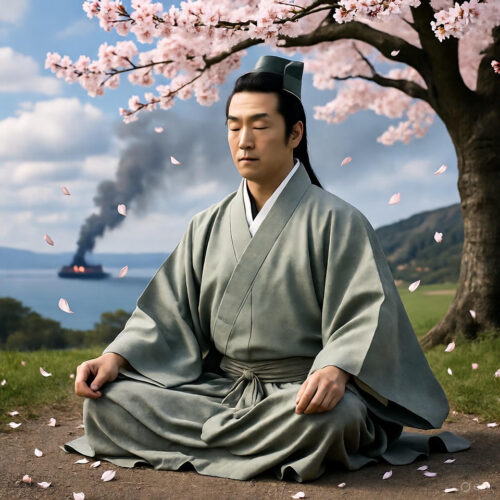
Archaeological echoes persist: excavations at Takashima reveal sunken Yuan ships with weapons, confirming explosive tech. Artifacts like bomb casings influenced Japanese metallurgy. Culturally, the event inspired noh plays, poetry, and ukiyo-e prints depicting divine winds scattering fleets. Zen’s rise, tied to Tokimune’s enlightenment, shifted samurai from pure martial prowess to disciplined mindfulness, laying groundwork for later philosophies.
Economically, invasions burdened Goryeo: forced labor led to uprisings, depleting timber for centuries. Japan turned inward, piracy (wokou) surging as unemployed samurai raided coasts, irking Yuan borders. Politically, Hōjō overreach post-victory alienated allies, culminating in the 1333 Kenmu Restoration attempt.
In 1274’s shadow, the Mongol machine—unbeaten on land—stumbled at sea, highlighting empire limits. Kublai’s 1281 retry mobilized 140,000 but met similar fate, cementing Japan’s mythic invincibility.
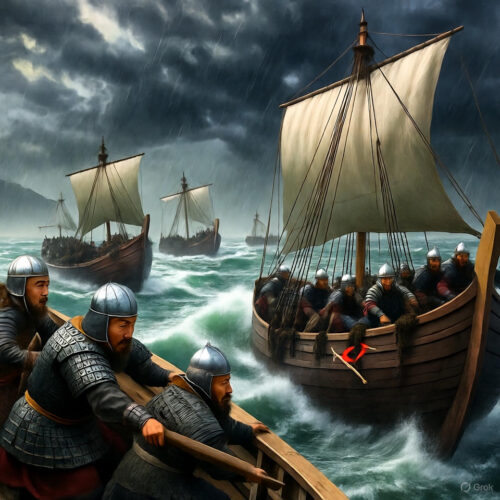
The outcome of this invasion—a thwarted conquest through grit and gale—teaches timeless lessons in resilience. In today’s world, where personal “invasions” come as career setbacks, health crises, or global uncertainties, the Japanese defenders’ unyielding spirit offers a blueprint for triumph.
– **Cultivate Inner Resolve Like Tokimune**: Start daily with 10 minutes of meditation to confront fears head-on, building mental fortitude against modern stressors like job loss—track progress in a journal to see how it sharpens decision-making.
– **Adapt to Unfamiliar Challenges**: Embrace new “weapons” like online courses for skill gaps, mirroring samurai learning from gunpowder; apply by dedicating one hour weekly to a disruptive technology in your field.
– **Build Alliances in Adversity**: Rally a personal network as gokenin did—schedule monthly check-ins with mentors or peers to share resources during tough times, fostering collective strength.
– **Prepare Proactively for Storms**: Stock “defenses” like emergency savings (aim for 6 months’ expenses) and diversified skills, just as Japan fortified coasts, to weather economic typhoons.
– **Honor Defiance with Action**: When facing overwhelming odds, take small defiant steps—like Suenaga’s charge—such as pitching a bold idea at work despite rejection risks, turning potential defeat into growth.
**A Personal Plan to Harness 1274’s Legacy**:
- **Week 1: Assess Your Tsushima**: Identify a current “invasion” (e.g., stagnant career) and journal threats, rating resilience on a 1-10 scale.
- **Weeks 2-4: Fortify Defenses**: Build habits—meditate daily, learn one new skill, network with three contacts—tracking via app for consistency.
- **Month 2: Simulate Battle**: Role-play challenges, like mock negotiations, to adapt tactics; review outcomes weekly.
- **Ongoing: Invoke the Divine Wind**: When storms hit, pause for reflection, then act decisively; celebrate small victories to sustain motivation.
- **Annual Review**: Revisit progress, adjusting as empires evolve, ensuring lifelong defiance.
This fusion of history’s drama and practical empowerment turns October 5, 1274, into a motivational cornerstone—proving that even against the khan’s horde, human will, allied with preparation, prevails.
